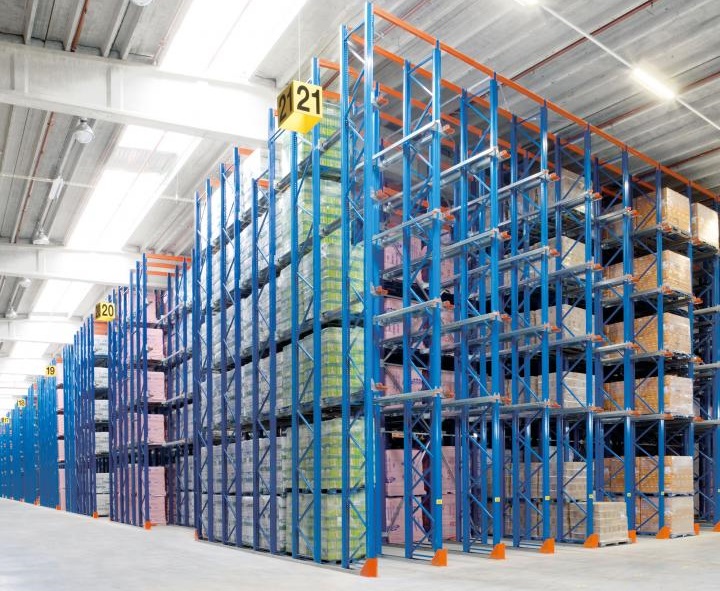Warehouses and distribution centres use high-density racking solutions of drive-in and drive-through pallet racking systems when seeking additional storage space. Although they share some similarities, their design and functionality are distinct. The main distinctions between drive-in and drive-through pallet racking are outlined below.
Characteristics of Drive-In Racking

Drive-in racking is characterised by its entry loading points only, resulting in a warehouse layout structure that is more accessible and less complex. Specifications of drive-in designs consist of:
Structure: Drive-in pallet racking is conventionally assembled, comprising horizontal beams and upright frameworks, which combine to form an array of storage lanes. The purpose of these lanes is to provide forklifts with access to the structure in order to retrieve or position pallets.
Entry and Exit: Pallets are loaded and discharged from the same side, typically the front side, using drive-in racking. Forklifts access the storage lanes to place or retrieve pallets, frequently in a single direction. By eliminating the necessity for aisles between the racking sections, this design maximises space utilisation.
LIFO: In general, drive-in racking systems adhere to the LIFO (last-in, first-out) principle. Due to the fact that the most recently laden pallets are stored posterior to the front pallets, pallet retrieval takes place in the opposite direction. Due to this feature, drive-in storage is appropriate for products with extended shelf lives that do not necessitate rigorous inventory rotation.
High-Density Storage: The capacity of drive-in racking to store data in a high-density manner is well-known. Through the reduction of aisle space, this system optimises the utilisation of the warehouse’s available space. It is advantageous for preserving substantial quantities of identical products, including perishable items or those that exhibit minimal variation.
Restricted Selectivity: Drive-in racking is primarily unsuitable due to its restricted selectivity. Pallets positioned at various depths within the storage sections necessitate the removal of the front pallets in order to gain access to those situated at greater depths. In comparison to more selective systems, such as selective racking, these constraints may cause longer retrieval times and diminished accessibility.
Drive-in racking is commonly employed to store Fast-Moving Consumer Goods (FMCG). Products requiring frequent restocking and in high demand are ideal candidates for drive-in racking. It is possible to store substantial quantities of canned products, packaged goods, toiletries, and cleaning supplies. Drive-in racking ensures expedient access to the most recent arrivals at the front of the storage channels while maximising space utilisation.
Characteristics of drive-through shelving

Drive-through pallet racking is a highly suitable alternative for facilitating a regulated and customisable movement of merchandise. This characteristic enhances its universality by allowing it to accommodate a wider variety of stowage requirements. The following are some characteristics of drive-through racking:
Structure: Comparable in design to drive-in racking, drive-through pallet racking is comprised of horizontal beams and upright frameworks that form storage lanes. Nonetheless, it is characteristic of having two entry sites, one at each extremity of the racking structure.
Access and Departure: In a drive-through setup, forklifts are allowed to enter and leave the storage lanes from both ends of the racking framework. The utilisation of a dual-entry configuration facilitates the loading and retrieval of pallets from opposing ends. It increases the flexibility of pallet retrieval and placement, thereby improving operational efficiency.
FIFO Principle: Drive-through storage systems typically adhere to the FIFO principle, which stands for First-In, First-Out. The implementation of access to both ends of the storage channels facilitates a methodical rotation of inventory. By loading pallets at one end and retrieving older stock from the other end as new stock arrives, inventory rotation is maintained. If desired, drive-through racking can also adhere to the LIFO principle.
Moderate Selectivity Drive-through racking provides a moderate degree of selectivity in comparison to drive-in racking. The utilisation of forklifts to access the front and rear pallets within the storage lanes facilitates inventory management. This system proves advantageous in situations requiring access to a wide variety of products or those with a high rate of inventory turnover.
Balanced Load Distribution: Drive-through racking facilitates a more equitable distribution of loads across the storage lanes by permitting entry and egress from both ends. By distributing the weight evenly, the structural integrity of the racking system is preserved, and overloading of particular channels is avoided. This characteristic is especially beneficial when stowing substantial or voluminous objects that necessitate an equitable distribution of weight.
Drive-in and drive-through are excellent high-density pallet storage solutions for high-volume material handling.
If you found this article interesting, you may also be interested in reading the following:
© 2024 Bowen Storage. All Rights Reserved











